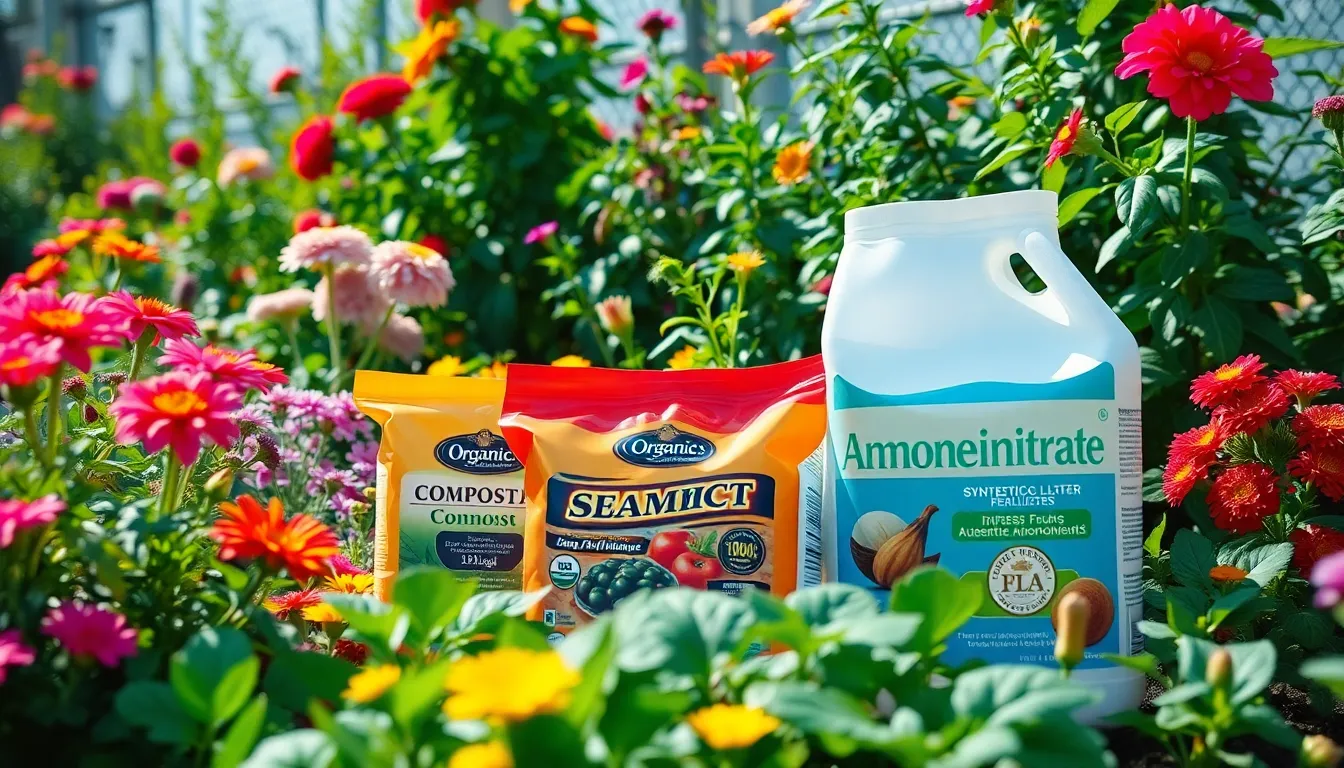Every gardener knows that plants are like teenagers—they need the right nutrients to thrive and can be a little picky about it. Choosing the best fertilizer for plants and flowers can feel like navigating a maze of options, each promising to turn a sad little sprout into a blooming masterpiece. But fear not! With a little guidance, anyone can discover the secret sauce that’ll make their garden the envy of the neighborhood.
Best Fertilizer For Plants And Flowers
Plants require a balanced supply of nutrients to thrive. Understanding these nutrient needs helps in selecting the best fertilizer for optimal growth.
Macronutrients
Macronutrients include nitrogen, phosphorus, and potassium, essential for growth. Nitrogen promotes healthy foliage and green color. Phosphorus encourages root development and flowering. Potassium strengthens plant resilience against diseases and drought. Fertilizers often come in ratios, such as 10-10-10, indicating equal parts of these macronutrients. Plants absorb these nutrients differently based on their life stages, making it vital to adjust fertilizer types accordingly.
Micronutrients
Micronutrients involve iron, manganese, zinc, and copper, essential in smaller quantities. Iron supports chlorophyll production, affecting photosynthesis efficacy. Manganese aids in enzyme function, crucial for plant metabolism. Zinc influences hormone production and tissue growth, while copper assists in photosynthesis and respiration processes. Soil testing can guide improvement efforts to address deficiencies, ensuring nutrient balance in the garden ecosystem.
Types of Fertilizers

Understanding fertilizer types helps gardeners select the right product for optimal plant health. Two primary categories exist: organic and synthetic fertilizers.
Organic Fertilizers
Organic fertilizers derive from natural sources. These materials include compost, manure, bone meal, and seaweed, enriching soil with essential nutrients. They improve soil structure and promote beneficial microbial activity. Their slow release ensures a steady nutrient supply over time, reducing the risk of over-fertilization. Products like fish emulsion provide necessary nitrogen, while rock phosphate supplies phosphorus. Organic options often enhance soil health, supporting long-term growth and sustainability.
Synthetic Fertilizers
Synthetic fertilizers contain chemically manufactured nutrients. These products deliver nutrients quickly, meeting immediate plant needs for growth and blooming. Common types include urea, ammonium nitrate, and superphosphate, each effective in specific situations. Ratio labels indicate nutrient content, guiding proper application. Quick absorption reduces the time plants wait for nutrients, but it carries a risk of overuse, leading to nutrient leaching and potential soil degradation. Gardeners often balance organic practices with synthetic options to achieve desired results efficiently.
Choosing the Best Fertilizer for Plants and Flowers
Selecting the right fertilizer requires an understanding of specific plant needs and available options. Factors such as nutrient content, application method, and growth stage play vital roles in choosing the best product.
Factors to Consider
Nutrient ratios represent a crucial aspect in selecting fertilizers. Products often come labeled with three numbers indicating the percentages of nitrogen, phosphorus, and potassium. Each nutrient supports different growth aspects; for example, nitrogen promotes leafy growth while phosphorus enhances root and bloom development. Soil type can also influence fertilizer effectiveness. Acidic and alkaline soils may require different nutrient solutions to ensure plant health. Additionally, application methods, such as granular or liquid forms, affect how nutrients are absorbed. Understanding the growth stage of plants further tailors fertilizer choices; young plants may need higher nitrogen levels, while flowering plants benefit from increased phosphorus.
Popular Fertilizer Brands
Several brands stand out in the fertilizer market, renowned for quality and performance. Miracle-Gro offers a wide range of products, including granular and liquid fertilizers suitable for many plants and flowers. Osmocote is known for its slow-release formulations, ideal for long-lasting plant nutrition. Fertilome provides specialized fertilizers focusing on specific plant types, ensuring targeted nutrient delivery. Jobe’s Organic is another popular choice among gardeners who prefer organic options, combining plant health with environmental sustainability. These brands, among others, offer diverse solutions to meet different gardening needs, helping transform gardens into vibrant displays.
Application Techniques
Applying fertilizers correctly is vital for maximizing plant and flower growth. Knowing when and how to apply these nutrients ensures they reach plants effectively.
Timing of Application
Timing plays a crucial role in fertilizer effectiveness. Generally, early spring serves as the best time to apply fertilizers, as plants begin their active growth phase. Mid-summer applications may help during peak growth but caution against over-fertilizing. For fall, it’s essential to provide a balanced fertilizer to strengthen roots for winter. Plants benefit from regular feeding schedules, typically every 4 to 6 weeks during the growing season, to maintain nutrient availability. Monitoring weather conditions assists in determining the right application time, avoiding application before heavy rain, which can wash nutrients away.
Methods of Application
Different methods suit various gardening needs and environments. Granular fertilizers can be spread evenly across soil surfaces, allowing for slow nutrient release. Liquid fertilizers, on the other hand, mix with water and deliver immediate nutrients, making them ideal for quick fixes. Foliar feeding applies liquid fertilizers directly to leaves and proves effective for plants with visible deficiencies. Soil injection involves using specialized tools to inject liquid fertilizer directly into the root zone, promoting targeted nutrient supply. Each method carries unique advantages, making it essential to select the appropriate technique based on specific plant requirements.
Conclusion
Choosing the right fertilizer can significantly impact the health and beauty of plants and flowers. By understanding the specific nutrient needs and selecting the appropriate fertilizer type, gardeners can create thriving gardens. Balancing organic and synthetic options ensures that plants receive both immediate and long-term benefits.
With the right application techniques and timing, gardeners can maximize growth and maintain vibrant displays. Armed with this knowledge, anyone can confidently transform their gardening experience and enjoy the rewards of a flourishing landscape.

